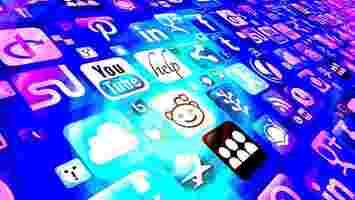Delete LinkedIn — you’ll have zero fucking regrets
I deleted LinkedIn this week.

I am enjoying a refreshing break from SEO and VA business development managers who want to connect in the name of synergy. From work/life coaches who “just want to ask me one question.” And from copy-paste content written by wannabe rockstar recruiters about the various times they either turned someone down or gave them a job on the spot.
I’ve been focusing on reducing the channels and interactions that I invest my time in.
Only being on platfor ms and creating content that I enjoy; that support my values of authenticity and reject notions of growth hacking bulls**t.
When was the last time LinkedIn gave you value?
It was my birthday the other day. I am slowly hacking my way into the jungle of my 30s, with a machete of tea, scones, and Castle reruns.
I spent the day receiving over 500 (!) birthday greetings from LinkedIn contacts, whose names and faces I didn’t even recognize, who had clicked on a notification prompt. Some of those birthday greetings were the only interaction I had ever had with these contacts.
When you care about the value of one-to-one, individual human interactions, it’s almost distressing to see communication reduced to such an impersonal level. I have no need for that.
I’m not alone in that. John Biggs at TechCrunch put it best:
I know some people find jobs, opportunities, and meaningful connections on the platform. I am not one of them. Even if I were, I don’t think I’d enjoy it. At this point, it would feel almost like telling my grandkids that I met my husband on Grindr. LinkedIn is a wildly disingenuous and inauthentic platform. It’s filled with people who are seemingly unable to reconcile the reality of their lives with the sheen and facade of curation. People who either believe or want to believe that their job announcements have the same weight as a Beyoncé album drop.
It’s a sales hellscape. It’s like being stuck in a depressing Willy Loman virtual experience
I know a thing or two about sales. I started my own business; it goes with the territory. My experience has taught me one thing. The only way to effectively sell to someone is to build an actual relationship with them, help them as much as you possibly can without having an agenda, give before you ever ask for anything, and show them that you have something to offer, without hammering on their door offering it.
That is the antithesis of LinkedIn. Where people send you off-brand and clumsy sales pitches at best — or at worst, scrape your details for scalable and utterly useless outbound campaigns. They send pitch decks in the same breath that they introduce themselves for the first time. They want you to buy with no reason why.
LinkedIn feels less like a platform for selling, and more like a platform for being sold to. A LinkedIn message is the 2020s equivalent of a cold sales call. You dread it. You hate it. You just don’t want to deal with it.
Apart from giving away your data in exchange for feeling like a sales prospect, LinkedIn doesn’t even work as a content platform
The numbers are often quite atrocious. The organic reach just isn’t there. A LinkedIn blog post is seen by a fraction of your 5,000+ connections. What’s the point in even publishing? A LinkedIn text post has more chance of being seen; but you’re competing with Bullshit, and in doing so, you’re dragging your content down to its level.
The content that works on LinkedIn has zero authenticity. Alex Kantrowitz and Ryan Mac from Buzzfeed identified one of the most insidious forms:
Frankly, I can do without.
I would rather focus my attention on platforms where I know people have come to genuinely research, interact, learn and consume. Quora. Angel List. Dribble. Medium. Substack. And yes, Twitter. And I would rather remove the false sense of accomplishment we get from engaging on LinkedIn, where we log into a landfill of utter shit several times a day and feel like we’ve done our bit of networking and growing, with no evidence to support that belief.
It’s not as scary as it seems.
It’s the pursuit of less, in honor of more. On platforms where the focus is on engaging, promoting, and climbing a social performance ladder, the only numbers that matter are the ones that measure popularity. Clicks. Likes. Shares. Comments. Any of which could have value in isolation, but in a co-dependent relationship with attention and its resulting ego boost, become little more than vanity metrics.
And vanity metrics are pointless.
I’d rather have 5 people reading my writing who actually give a shit in a meaningful way, than 5,000 who couldn’t care less.
So, no. I don’t want to add you to my professional network on LinkedIn.
If that’s your goal, I’d rather add you to a blocklist.
Here are the 3 biggest trends shaping the future of work
Did you know Tamar Yehoshua, Slack’s Chief Product Officer, is speaking at TNW2020 this year? Check out their session on ‘Human-centricity: building products with customers’ here .

If companies had faces, the months of lockdown would show a decade’s worth of age. Not only has the pandemic completely upended how we work; it’s forced us to re-examine our roles as employers and employees, our goals, our values, and how we merge work and home life.
But as they say, with age (and wrinkles) comes wisdom. We’ve written at length about how businesses have responded to the global crisis. Now the question we’re asking ourselves is: What will this change in the long run? Are we looking at fundamental, system-wide changes in the way we work, or will things creep back to the way they were?
Increasingly, it seems like the former. In our Slack Sessions virtual event, which featured panel discussions with global business leaders, Greg Williams, the editor in chief of Wired UK, explored the future of work with Stuart Templeton, the head of Slack UK, and Barry O’Reilly, an entrepreneur, business advisor and best-selling author of Unlearn: Let Go of Past Success to Achieve Extraordinary Results . The event included a panel discussion with some of Slack’s biggest customers in the U.K., including the Financial Times, HSBC and department-store company John Lewis & Partners.
Several common themes emerged, such as the importance of agility, flat communication and asynchronous workstreams. We’re all learning—and unlearning—new ways of working, and these three trends will likely shape the future of work.
Trend 1: Agility is the new currency of business
Agility has emerged as a critical operating principle during the pandemic. Whereas once companies were hyper-focused on scale and growth, many have shifted their attention to fast adaptation. “The muscle you need to build is to continually adapt to changing circumstances,” O’Reilly says. “If you can build or cultivate that characteristic in [your company], it doesn’t matter what problems come at you.”
Many Slack customers flexed the agility muscle during the pandemic. For instance, the FT, a business news organization, launched a new content management system within the first week of lockdown. The new system allowed its journalists to transition to remote work without needing to use a VPN. The FT had been planning to make the transition prior to the pandemic, but the pandemic compressed the timeline, demanding a quick and agile response from the company.
Multinational bank HSBC also executed a rapid pivot during the COVID-19 crisis. The bank was using Slack in its product development team before the pandemic. But once the company moved away from physical offices, Slack usage rose 30% for active users and daily messages shot up by 80%, all within the first month, according to Jamie Newham, the digital collaboration lead at HSBC. “We already had a live Slack instance, and the scalability was ready. We didn’t need to do much apart from really just put people on it,” he says.
These examples of corporate agility are not one-offs, says Williams: “The kinds of companies that are going to thrive … are looking for agility rather than scale, and distributed working fits perfectly in this paradigm.”
Such rapid mobilization will likely have lasting cultural effects too. Newham was astonished to see “what’s possible” when a company is forced to respond rapidly. He adds that there’s been a culture shift at HSBC as perceived roadblocks are overcome with a “you can get these things done” mentality. “I think that mindset has definitely changed us from being a classic bank to being more agile,” he says. In the future, “we have to accept a little bit more risk and do things to develop and change.”
Trend 2: Empowering teams to work asynchronously
Perhaps one of the biggest challenges for companies going remote for the first time is navigating presenteeism—the practice of staying in the office for appearance’s sake, even if you’re not really working. Not only will this practice wane in a post-coronavirus world, according to the panelists, but companies will also be more likely to accept that everyone works on different schedules.
This is especially true at fast-paced news organizations. “It’s obvious now that we’re not all working at the same time,” says Sarah Wells, a technical director for the FT. “We have to work out how we can make progress asynchronously. For instance, we had a meeting-heavy culture, and we really want to cut back on that.”
As a parent of school-age children, Claire Nelson, a product engineer at John Lewis & Partners, has keenly felt the need for flexible work schedules. “I used to go into the office really early and leave mid-afternoon,” she says. “Now homeschooling takes priority first thing in the morning. I’ve got my mobile next to me in case something urgent crops up, but ‘business as usual’ now starts two and a half hours later than it would have done previously for me.”
On the flip side, Nelson has colleagues who start their days before their children wake up and then wrap up the workday early. “We’ve got lots of different working patterns, which we’re showing is achievable and hopefully sustainable,” she says.
Templeton thinks the pandemic is forcing companies to re-examine their goals altogether. “This is a time where we have to align ourselves around outcomes and become far more outcome-focused than office-focused,” he says. In other words, it doesn’t matter how hard you work or how long you spend in Slack, as long as you get the job done.
Trend 3: Staying connected through flat communication structures
As offices shut down, many companies adjusted their internal communication strategies to keep employees engaged and connected with one another. Prior to COVID-19, HSBC used what Newham describes as a “classic” model for employee communications: email. Now the bank’s communications team uses Slack channels for most of its announcements. “[Slack] allows people to interact with the communication rather than just reading it, which is very different and has had quite a big impact,” he says.
Not all communication needs to be (or should be) formal. Panelists agreed on the importance of scheduling more frequent check-ins with individuals and teams. At the FT, managers have buffered in more time during meetings for non-work chat. “For the first month, we had a lot of virtual team coffee mornings, but gradually people stopped coming,” Wells says. “So now we’ll just take a bit more time to talk about what’s happening in people’s lives.”
Another key to unlocking fluid communication is simply being accessible. “I really think the main thing is being there and being available,” Newham says, “and Slack really helps us to do that, rather than having to send an email or reach out to somebody in a complicated way. It has really changed how we work.”
A catalyst for change
For most companies, none of these trends are completely new. What is new is the speed at which we must respond and adapt, not just structurally as an organization, but culturally as well. “The pandemic has catalyzed changes that were already underway,” Williams says. “The companies that are going to thrive and attract talent are going to be those that don’t go back to the old way of working.”
This article was originally published on Slack’s blog by Sara Yin. You can read it here .
3 critical App Store Optimization mistakes you’re overlooking
